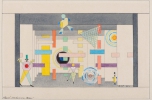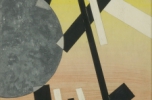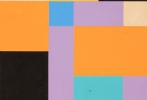Bauhaus100. Abstract Revue
Selected Works from the Estate of Andor Weininger
Hungarian National Gallery, 29 March – 28 July 2019
Photos: Hungarian National Gallery
To mark the centenary of the founding of the Bauhaus and the 120th anniversary of the birth of Andor Weininger, an exhibition organised from the artist’s legacy will open in the Hungarian National Gallery. In 2002 eighty works and another eighty smaller sketches entered the collection of the Gallery from the oeuvre of Weininger; a selection of this material will be on public display for the first time with the title Abstract Revue.
The Bauhaus, founded in 1919 in Weimar, is one of the cradles of Modern art, architecture industrial design, theatre and applied arts. The school established by Walter Gropius and led by him until 1928 provided students with diverse and practice-oriented training free from academic constraints. It had more than thirty Hungarian students – among them Andor Weininger – and prominent Hungarian artists – for example Marcell Breuer and László Moholy-Nagy – could be found in its international teaching staff.
Andor Weininger (1899, Karancs [today Karanac, Croatia] – 1986, New York) – a painter, graphic artist, illustrator, musician, architect, furniture-, stage set- and costume-designer – was born in the south of Baranya County into a family of Hungarian, German and Yugoslav ethnicity. He went to the Cistercian secondary school in Pécs in 1913, where one of his classmates, Ferenc Martyn, introduced him to József Rippl-Rónai, who – as attested to by the paintings displayed at our exhibition – exerted a major influence on Weininger with the pictures of his so-called ‘corn period’. After studying law in Pécs for a year, following the example of a friend, Farkas Molnár, Weininger pursued architectural studies at the Technical University of Budapest in 1918–1919. He worked in Pécs in 1920–1921, while attending an evening course of drawing nudes and joined in the activities of the Modern Circle of Artists in Pécs. Together with his fellow painters, Farkas Molnár, Henrik Stefán and Hugó Johan, he was accepted at the Bauhaus in Weimar in October 1921. After completing the foundation course of the school in 1921–1922, Weininger enrolled in the Mural Painting Workshop, led at the time by Wassily Kandinsky and Carl Schlemmer. Influenced by the Dutch Theo van Doesburg, Weininger became captivated by a utopian aesthetic composed with pure colours and simple geometric forms. In early 1923 he designed stage sets and costumes in Hamburg, while also participating in performances as a compére, an actor and a musician. It was here that he began to develop the concept of the Mechanical Stage Revue, in which he envisioned a stage populated with moving abstract forms. He made numerous sketches, which he later further improved and eventually arrived at a moving geometrical and abstract scenery created by moving various elements forward, backward, up and down, while rhythmically moving the sides, the ceiling and the floor of the stage. Abstract stage productions based on Weininger’s ideas were only realised at the end of the artist’s life. The Budapest audience will be able to see the video of the debut performance, recorded at the Kassel documenta of 1986, for the first time in Hungary at our exhibition.
Weininger returned to the Bauhaus in the middle of 1923, and in 1924 he founded the Bauhaus Band. From 1925, already an employee of the Bauhaus school, by then relocated from Weimar to Dessau, he was in charge of communication and the Stage Workshop. The German political situation of the late 1930s forced him to first move to the Netherlands and then to Canada, and from 1985 he lived in the United States. A selection of the material comprising eighty works and eighty smaller sketches, which had entered the collection of the Hungarian National Gallery from the Weininger legacy in 2002, will debut at the Gallery this March to celebrate the centenary of the founding of the Bauhaus and the 120th anniversary of the artist’s birth.
The start of Weininger’s career will be presented at our exhibition through some works by his fellow Bauhaus artists from Pécs – Farkas Molnár, Henrik Stefán and Johan Hugó – that have not been displayed together in Budapest before now; a work each by Alfréd Forbát and Sándor Bortnyik, and two by László Moholy-Nagy will also document Weininger’s connection with the Hungarian artists of the Bauhaus.
The focal point of the exhibition will be one of Weininger’s most compelling projects, the Mechanical Stage Revue, anticipating today’s digital visual world. Our installation built around this concept will have a curiosity at its centre: the film footage of a performance from the 1980s.



